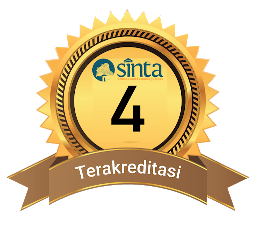Analisis Kesiapan Guru IPA/Kimia Terhadap Penerapan Pembelajaran STEM (Science Technology, Engineering, Mathematics) di SMA/SMK/MA Negeri Se Kecamatan Gerung
DOI:
10.29303/cep.v8i1.6313Published:
2025-05-31Issue:
Vol. 8 No. 1 (2025): Edisi MeiKeywords:
Teacher Readiness, Application of Learning, STEMArticles
Downloads
How to Cite
Abstract
This study aims to describe the readiness of science/chemistry teachers for the application of STEM learning (Science, Technology, Engineering, Mathematics) and to describe the supporting and inhibiting factors of science/chemistry teacher readiness for the application of STEM learning. This research is a descriptive research with a quantitative approach. The population of this study is the number of science/chemistry teachers who teach at SMA/SMK/MA Country in District Gerung. The sampling technique in this study used purposive sampling. The number of samples was 12 science/chemistry teachers in SMA/SMK/MA Country in District Gerung. Data collection techniques using interview guidelines and questionnaire techniques which have been declared valid and reliable. The results of the research on attitude readiness, emotional readiness, cognitive readiness and behavioral readiness in public SMA/SMK/MA Country in District showed an average gain of 74.04%. This means that the readiness of science/chemistry teachers towards the application of STEM learning is more likely to be ready. Based on this, it can be interpreted that some teachers have implemented STEM learning and have never implemented STEM learning, only to the extent that they are ready to do STEM learning. This readiness is also influenced by supporting factors such as: responsibility, enthusiasm, willingness to adapt, critical thinking, thinking contextually, aware of one's own worth and will, being able to integrate various scientific disciplines, carrying out partnership functions and being good at managing time. While the inhibiting factors are independence and awareness of strengths and weaknesses, this is because some teachers have never participated in STEM learning training and teachers have never tried to apply STEM education in science/chemistry learning. Furthermore, teachers find it difficult to improve their quality in preparation for implementing STEM learning and teachers are not yet proficient in preparing lesson plans that are appropriate to STEM learning.
References
Abdullah, A. H., Hamzah, M. H., Hussin, R. H. S. R., Kohar, U. H. A., Rahman, S. N. S. A., & Junaidi, J. (2017). Teachers’ readiness in implementing science, technology, engineering and mathematics (STEM) education from the cognitive, affective and behavioural aspects. Proceedings of 2017 IEEE International Conference on Teaching, Assessment and Learning for Engineering, TALE 2017, 2018-Janua(December 2017), 6–12. https://doi.org/10.1109/TALE.2017.8252295
Anjarsari, N. (2020). The Teacher Readiness Towards The Application of STEM Learning. BELIA: Early Childhood Education. 9(2), 80–88. https://journal.unnes.ac.id/sju/index.php/belia/article/view/36174
Fathoni, A., Muslim, S., Ismayati, E., Rijanto, T., Munoto, & Nurlaela, L. (2020). STEM : Inovasi Dalam Pembelajaran Vokasi. Jurnal Pendidikan Teknologi Dan Kejuruan, 17(1), 33–42.
Idrus, S. W. Al, & Suma, K. (2022). Analisis Problematika Pembelajaran Kimia Berbasis Etno-STEM dari Aspek Kurikulum. Jurnal Ilmiah Profesi Pendidikan, 7(2c), 935–940. https://doi.org/10.29303/jipp.v7i2c.574
Mulyani, T. (2019). Pendekatan pembelajaran STEM untuk menghadapi revolusi industry 4.0. In Prosiding Seminar Nasional Pascasarjana (Vol. 2, No. 1, pp. 453-460)
Nila, N. putu, & Jayanti. (2022). Kesiapan Guru Dalam Melaksanakan Pembelajaran New Normal Pada Anak Usia Dini. Jurnal Pendidikan Anak Usia Dini …, 10, 397–407. https://ejournal.undiksha.ac.id/index.php/JJPAUD/article/view/5338
Purwanto. (2008). Metode Penelitian Kuantitatif. Pustaka Belajar.
Purwanto, N. (2013). Prinsip-prinsip dan Teknik Evaluasi Pengajaran. Remaja Rosdakarya.
Saleh, S. (2018). Statistika Pendidikan. CV Widya Puspita.
Sari, N. D., & Setiawan, J. (2020). Papan gekola sebagai media pembelajaran matematika yang inovatif dengan pendekatan STEAM. Jurnal Saintika Unpam: Jurnal Sains Dan Matematika Unpam, 3(1), 31-41.
Slameto, D. (2015). Belajar Dan Faktor-Faktor Yang Mempengaruhi. Rineka Cipta.
Sriyati, S. (2018). Upaya Mengembangkan Kemampuan Guru Kota Bandung Dan Sekitarnya Untuk Mendesain Pembelajaran Berbasis STEM (Science, Technology, Engineering And Mathematics) Melalui Kegiatan Lokakarya. Seminar Nasional Hasil PKM LPM Universitas Pasudan, 949–963.
Sumardi. (2020). Teknik Pengukuran dan Penilaian Hasil Belajar. CV Budi Utama.
Syadiah, A. N. (2020). Analisis Rasch Untuk Soal Tes Berpikir Kritis Pada Pembelajaran STEM Di Sekolah Dasar. Jurnal Pendidikan Dasar Dan Pembelajaran, 10 (2):138.
Syahirah, M., Anwar, L., & Holiwarni, B. (2020). Pengembangan Modul Berbasis STEM (Science, Technology, Engineering And Mathematics) Pada Pokok Bahasan Elektrokimia. Jurnal Pijar Mipa, 15(4), 317–324. https://doi.org/10.29303/jpm.v15i4.1602
Author Biography
Elok Faiqotuzzahrok, Universitas Mataram
License
Copyright (c) 2025 Elok Faiqotuzzahrok; Syarifa Wahidah Al Idrus, Eka Junaidi, Saprizal Hadisaputra

This work is licensed under a Creative Commons Attribution-ShareAlike 4.0 International License.
Authors who publish with Chemistry Education Practice agree to the following terms:
- Authors retain copyright and grant the journal right of first publication with the work simultaneously licensed under a Creative Commons Attribution License 4.0 International License (CC-BY-SA License). This license allows authors to use all articles, data sets, graphics, and appendices in data mining applications, search engines, web sites, blogs, and other platforms by providing an appropriate reference. The journal allows the author(s) to hold the copyright without restrictions and will retain publishing rights without restrictions.
- Authors are able to enter into separate, additional contractual arrangements for the non-exclusive distribution of the journal's published version of the work (e.g., post it to an institutional repository or publish it in a book), with an acknowledgement of its initial publication in Chemistry Education Practice.
- Authors are permitted and encouraged to post their work online (e.g., in institutional repositories or on their website) prior to and during the submission process, as it can lead to productive exchanges, as well as earlier and greater citation of published work (See The Effect of Open Access).






